Critical Analysis of Workplace Diversity in Tourism and Hospitality Industry
VerifiedAdded on 2022/10/02
|9
|2276
|196
AI Summary
This paper provides a critical analysis of workplace diversity in the tourism and hospitality industry. It identifies and analyzes the three major challenges faced by HR managers in managing a diverse workforce. The paper also reviews the best practices adopted by HR teams to address workplace diversity and provides solutions and recommendations for promoting diversity in the workplace.
Contribute Materials
Your contribution can guide someone’s learning journey. Share your
documents today.
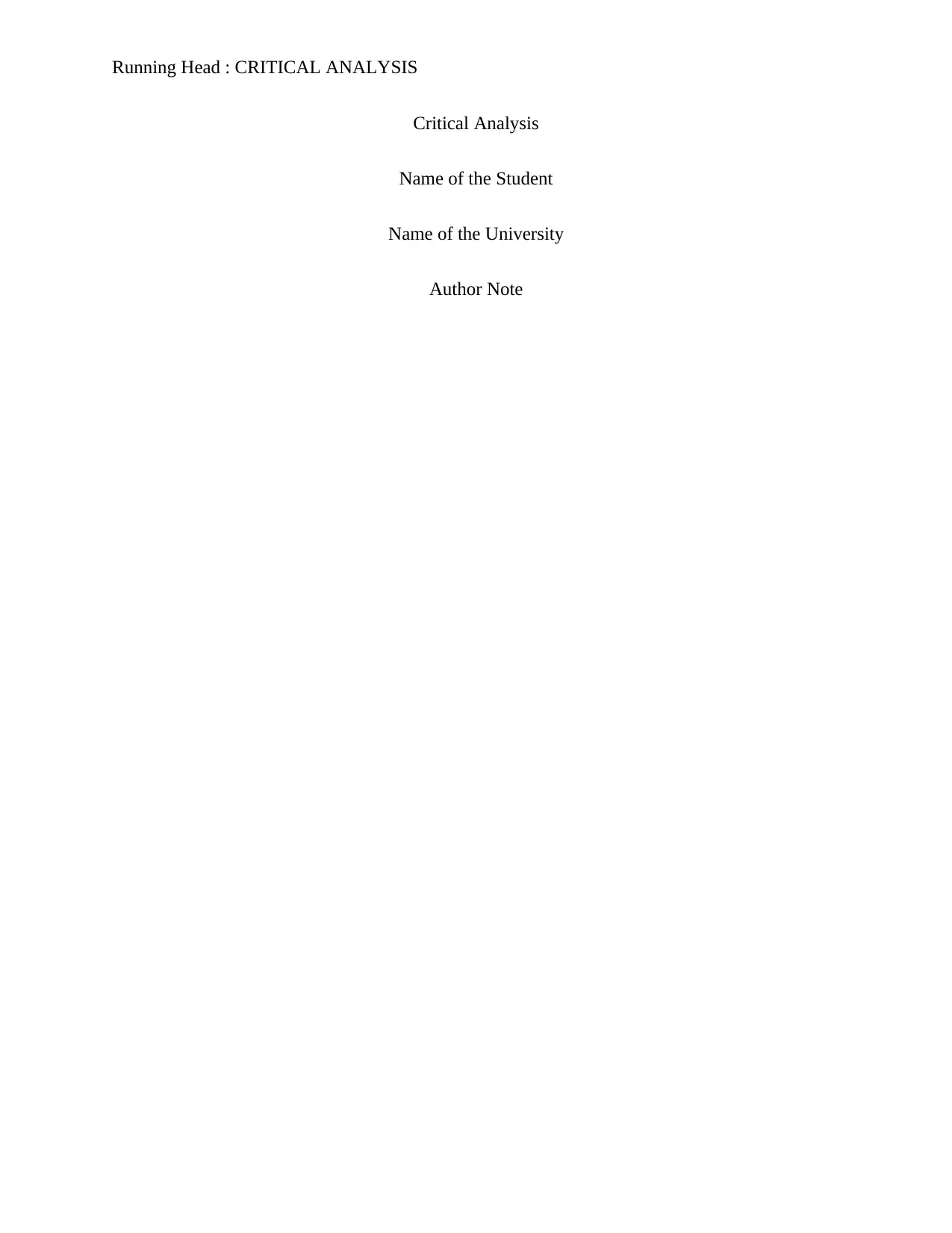
Running Head : CRITICAL ANALYSIS
Critical Analysis
Name of the Student
Name of the University
Author Note
Critical Analysis
Name of the Student
Name of the University
Author Note
Secure Best Marks with AI Grader
Need help grading? Try our AI Grader for instant feedback on your assignments.
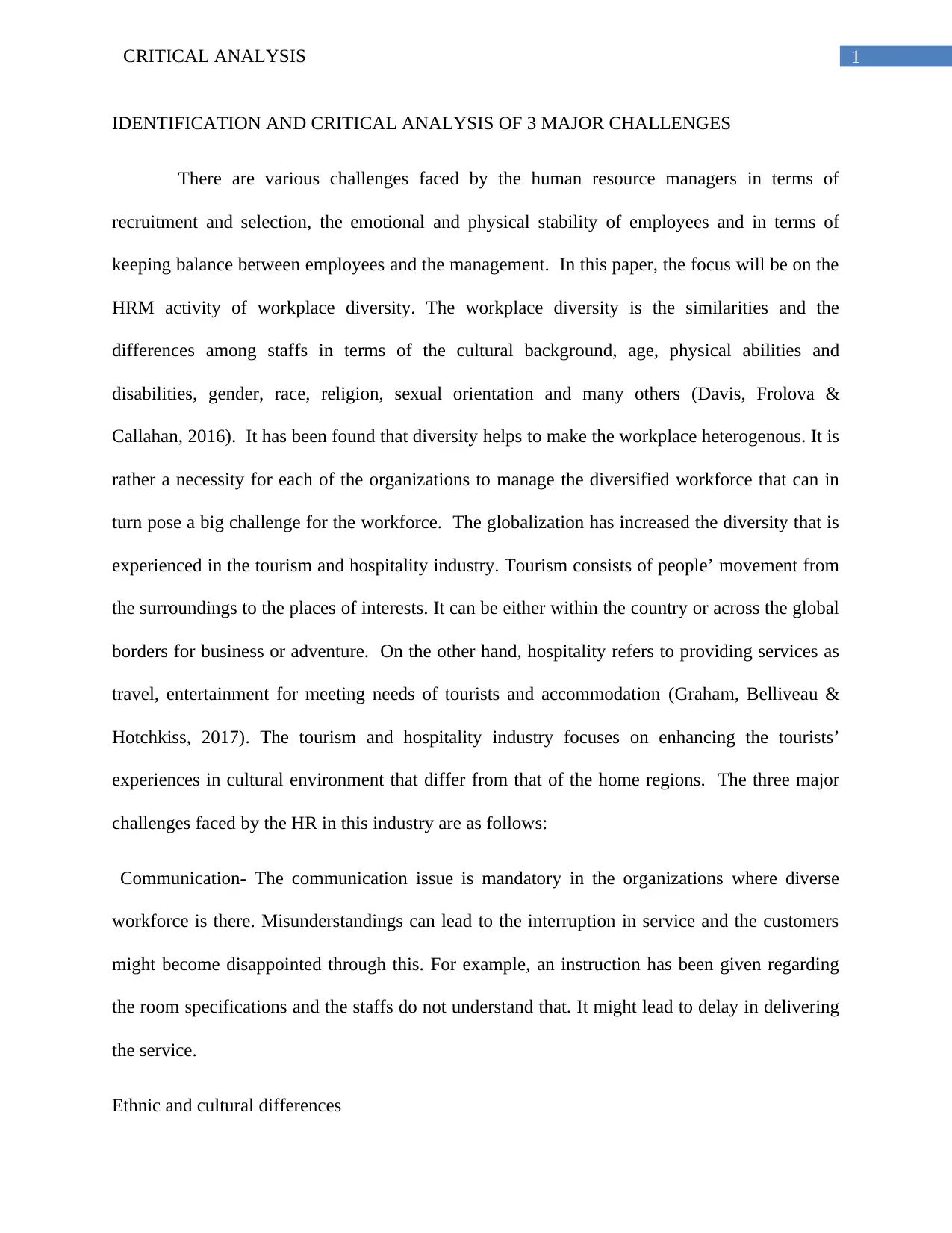
1CRITICAL ANALYSIS
IDENTIFICATION AND CRITICAL ANALYSIS OF 3 MAJOR CHALLENGES
There are various challenges faced by the human resource managers in terms of
recruitment and selection, the emotional and physical stability of employees and in terms of
keeping balance between employees and the management. In this paper, the focus will be on the
HRM activity of workplace diversity. The workplace diversity is the similarities and the
differences among staffs in terms of the cultural background, age, physical abilities and
disabilities, gender, race, religion, sexual orientation and many others (Davis, Frolova &
Callahan, 2016). It has been found that diversity helps to make the workplace heterogenous. It is
rather a necessity for each of the organizations to manage the diversified workforce that can in
turn pose a big challenge for the workforce. The globalization has increased the diversity that is
experienced in the tourism and hospitality industry. Tourism consists of people’ movement from
the surroundings to the places of interests. It can be either within the country or across the global
borders for business or adventure. On the other hand, hospitality refers to providing services as
travel, entertainment for meeting needs of tourists and accommodation (Graham, Belliveau &
Hotchkiss, 2017). The tourism and hospitality industry focuses on enhancing the tourists’
experiences in cultural environment that differ from that of the home regions. The three major
challenges faced by the HR in this industry are as follows:
Communication- The communication issue is mandatory in the organizations where diverse
workforce is there. Misunderstandings can lead to the interruption in service and the customers
might become disappointed through this. For example, an instruction has been given regarding
the room specifications and the staffs do not understand that. It might lead to delay in delivering
the service.
Ethnic and cultural differences
IDENTIFICATION AND CRITICAL ANALYSIS OF 3 MAJOR CHALLENGES
There are various challenges faced by the human resource managers in terms of
recruitment and selection, the emotional and physical stability of employees and in terms of
keeping balance between employees and the management. In this paper, the focus will be on the
HRM activity of workplace diversity. The workplace diversity is the similarities and the
differences among staffs in terms of the cultural background, age, physical abilities and
disabilities, gender, race, religion, sexual orientation and many others (Davis, Frolova &
Callahan, 2016). It has been found that diversity helps to make the workplace heterogenous. It is
rather a necessity for each of the organizations to manage the diversified workforce that can in
turn pose a big challenge for the workforce. The globalization has increased the diversity that is
experienced in the tourism and hospitality industry. Tourism consists of people’ movement from
the surroundings to the places of interests. It can be either within the country or across the global
borders for business or adventure. On the other hand, hospitality refers to providing services as
travel, entertainment for meeting needs of tourists and accommodation (Graham, Belliveau &
Hotchkiss, 2017). The tourism and hospitality industry focuses on enhancing the tourists’
experiences in cultural environment that differ from that of the home regions. The three major
challenges faced by the HR in this industry are as follows:
Communication- The communication issue is mandatory in the organizations where diverse
workforce is there. Misunderstandings can lead to the interruption in service and the customers
might become disappointed through this. For example, an instruction has been given regarding
the room specifications and the staffs do not understand that. It might lead to delay in delivering
the service.
Ethnic and cultural differences
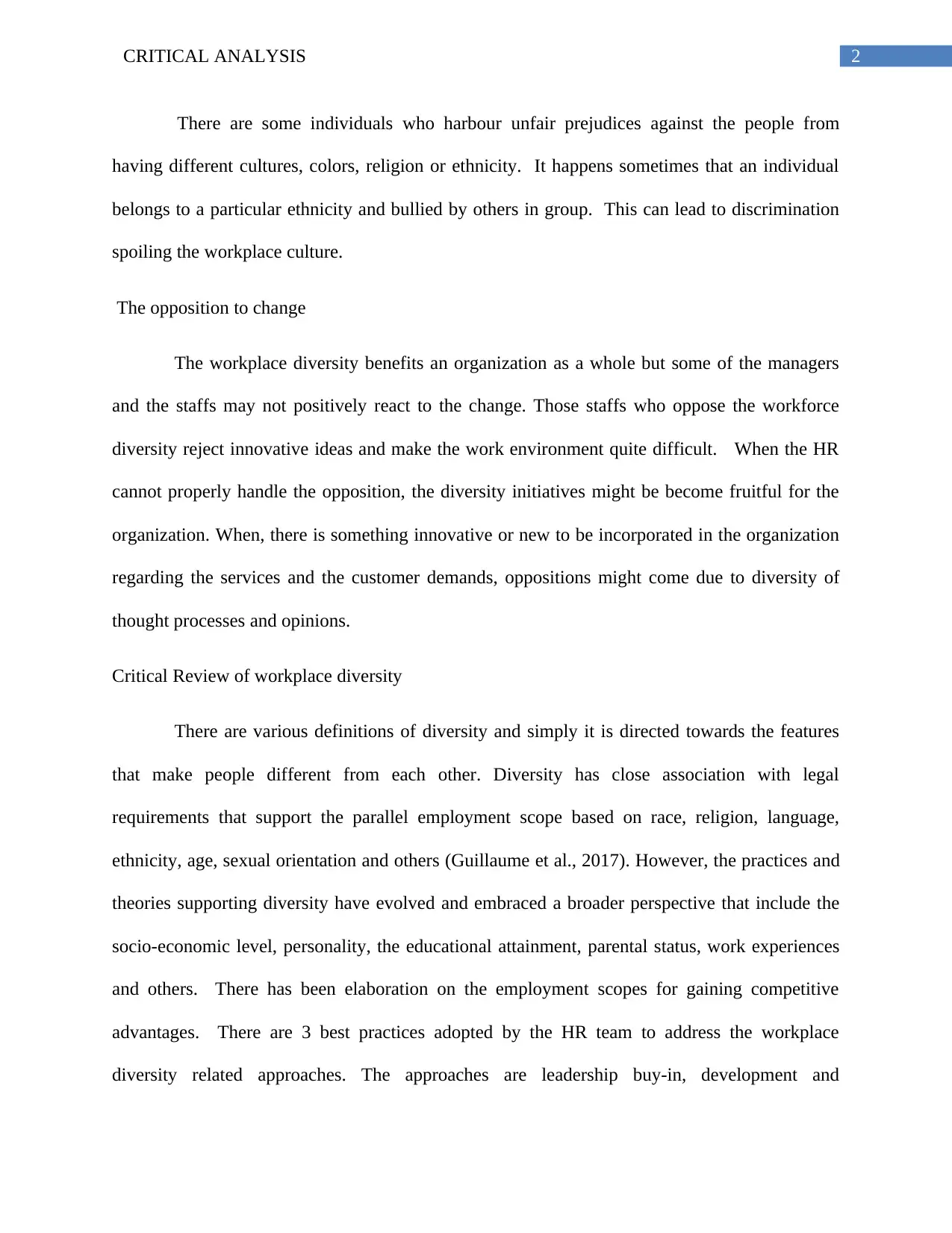
2CRITICAL ANALYSIS
There are some individuals who harbour unfair prejudices against the people from
having different cultures, colors, religion or ethnicity. It happens sometimes that an individual
belongs to a particular ethnicity and bullied by others in group. This can lead to discrimination
spoiling the workplace culture.
The opposition to change
The workplace diversity benefits an organization as a whole but some of the managers
and the staffs may not positively react to the change. Those staffs who oppose the workforce
diversity reject innovative ideas and make the work environment quite difficult. When the HR
cannot properly handle the opposition, the diversity initiatives might be become fruitful for the
organization. When, there is something innovative or new to be incorporated in the organization
regarding the services and the customer demands, oppositions might come due to diversity of
thought processes and opinions.
Critical Review of workplace diversity
There are various definitions of diversity and simply it is directed towards the features
that make people different from each other. Diversity has close association with legal
requirements that support the parallel employment scope based on race, religion, language,
ethnicity, age, sexual orientation and others (Guillaume et al., 2017). However, the practices and
theories supporting diversity have evolved and embraced a broader perspective that include the
socio-economic level, personality, the educational attainment, parental status, work experiences
and others. There has been elaboration on the employment scopes for gaining competitive
advantages. There are 3 best practices adopted by the HR team to address the workplace
diversity related approaches. The approaches are leadership buy-in, development and
There are some individuals who harbour unfair prejudices against the people from
having different cultures, colors, religion or ethnicity. It happens sometimes that an individual
belongs to a particular ethnicity and bullied by others in group. This can lead to discrimination
spoiling the workplace culture.
The opposition to change
The workplace diversity benefits an organization as a whole but some of the managers
and the staffs may not positively react to the change. Those staffs who oppose the workforce
diversity reject innovative ideas and make the work environment quite difficult. When the HR
cannot properly handle the opposition, the diversity initiatives might be become fruitful for the
organization. When, there is something innovative or new to be incorporated in the organization
regarding the services and the customer demands, oppositions might come due to diversity of
thought processes and opinions.
Critical Review of workplace diversity
There are various definitions of diversity and simply it is directed towards the features
that make people different from each other. Diversity has close association with legal
requirements that support the parallel employment scope based on race, religion, language,
ethnicity, age, sexual orientation and others (Guillaume et al., 2017). However, the practices and
theories supporting diversity have evolved and embraced a broader perspective that include the
socio-economic level, personality, the educational attainment, parental status, work experiences
and others. There has been elaboration on the employment scopes for gaining competitive
advantages. There are 3 best practices adopted by the HR team to address the workplace
diversity related approaches. The approaches are leadership buy-in, development and
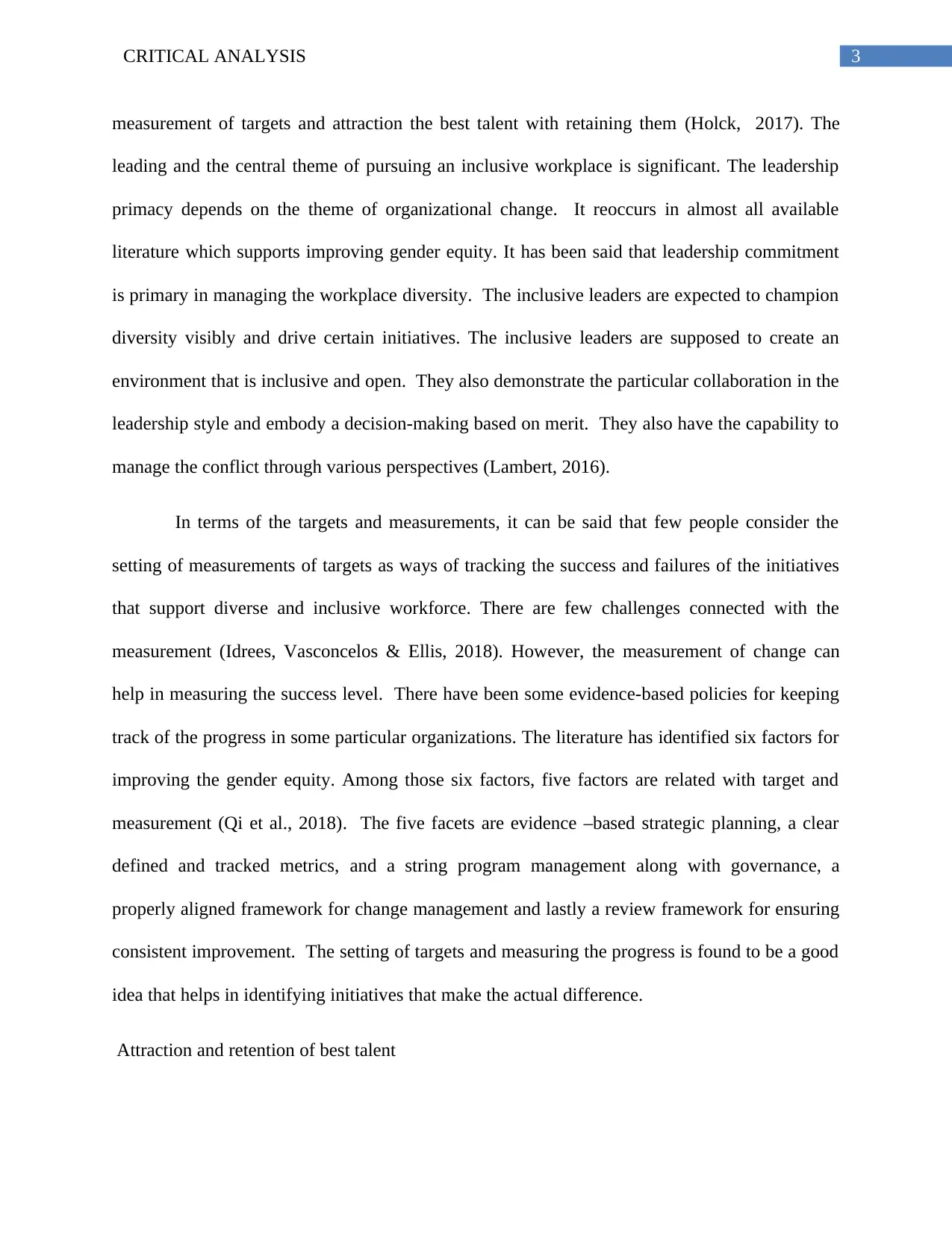
3CRITICAL ANALYSIS
measurement of targets and attraction the best talent with retaining them (Holck, 2017). The
leading and the central theme of pursuing an inclusive workplace is significant. The leadership
primacy depends on the theme of organizational change. It reoccurs in almost all available
literature which supports improving gender equity. It has been said that leadership commitment
is primary in managing the workplace diversity. The inclusive leaders are expected to champion
diversity visibly and drive certain initiatives. The inclusive leaders are supposed to create an
environment that is inclusive and open. They also demonstrate the particular collaboration in the
leadership style and embody a decision-making based on merit. They also have the capability to
manage the conflict through various perspectives (Lambert, 2016).
In terms of the targets and measurements, it can be said that few people consider the
setting of measurements of targets as ways of tracking the success and failures of the initiatives
that support diverse and inclusive workforce. There are few challenges connected with the
measurement (Idrees, Vasconcelos & Ellis, 2018). However, the measurement of change can
help in measuring the success level. There have been some evidence-based policies for keeping
track of the progress in some particular organizations. The literature has identified six factors for
improving the gender equity. Among those six factors, five factors are related with target and
measurement (Qi et al., 2018). The five facets are evidence –based strategic planning, a clear
defined and tracked metrics, and a string program management along with governance, a
properly aligned framework for change management and lastly a review framework for ensuring
consistent improvement. The setting of targets and measuring the progress is found to be a good
idea that helps in identifying initiatives that make the actual difference.
Attraction and retention of best talent
measurement of targets and attraction the best talent with retaining them (Holck, 2017). The
leading and the central theme of pursuing an inclusive workplace is significant. The leadership
primacy depends on the theme of organizational change. It reoccurs in almost all available
literature which supports improving gender equity. It has been said that leadership commitment
is primary in managing the workplace diversity. The inclusive leaders are expected to champion
diversity visibly and drive certain initiatives. The inclusive leaders are supposed to create an
environment that is inclusive and open. They also demonstrate the particular collaboration in the
leadership style and embody a decision-making based on merit. They also have the capability to
manage the conflict through various perspectives (Lambert, 2016).
In terms of the targets and measurements, it can be said that few people consider the
setting of measurements of targets as ways of tracking the success and failures of the initiatives
that support diverse and inclusive workforce. There are few challenges connected with the
measurement (Idrees, Vasconcelos & Ellis, 2018). However, the measurement of change can
help in measuring the success level. There have been some evidence-based policies for keeping
track of the progress in some particular organizations. The literature has identified six factors for
improving the gender equity. Among those six factors, five factors are related with target and
measurement (Qi et al., 2018). The five facets are evidence –based strategic planning, a clear
defined and tracked metrics, and a string program management along with governance, a
properly aligned framework for change management and lastly a review framework for ensuring
consistent improvement. The setting of targets and measuring the progress is found to be a good
idea that helps in identifying initiatives that make the actual difference.
Attraction and retention of best talent
Secure Best Marks with AI Grader
Need help grading? Try our AI Grader for instant feedback on your assignments.
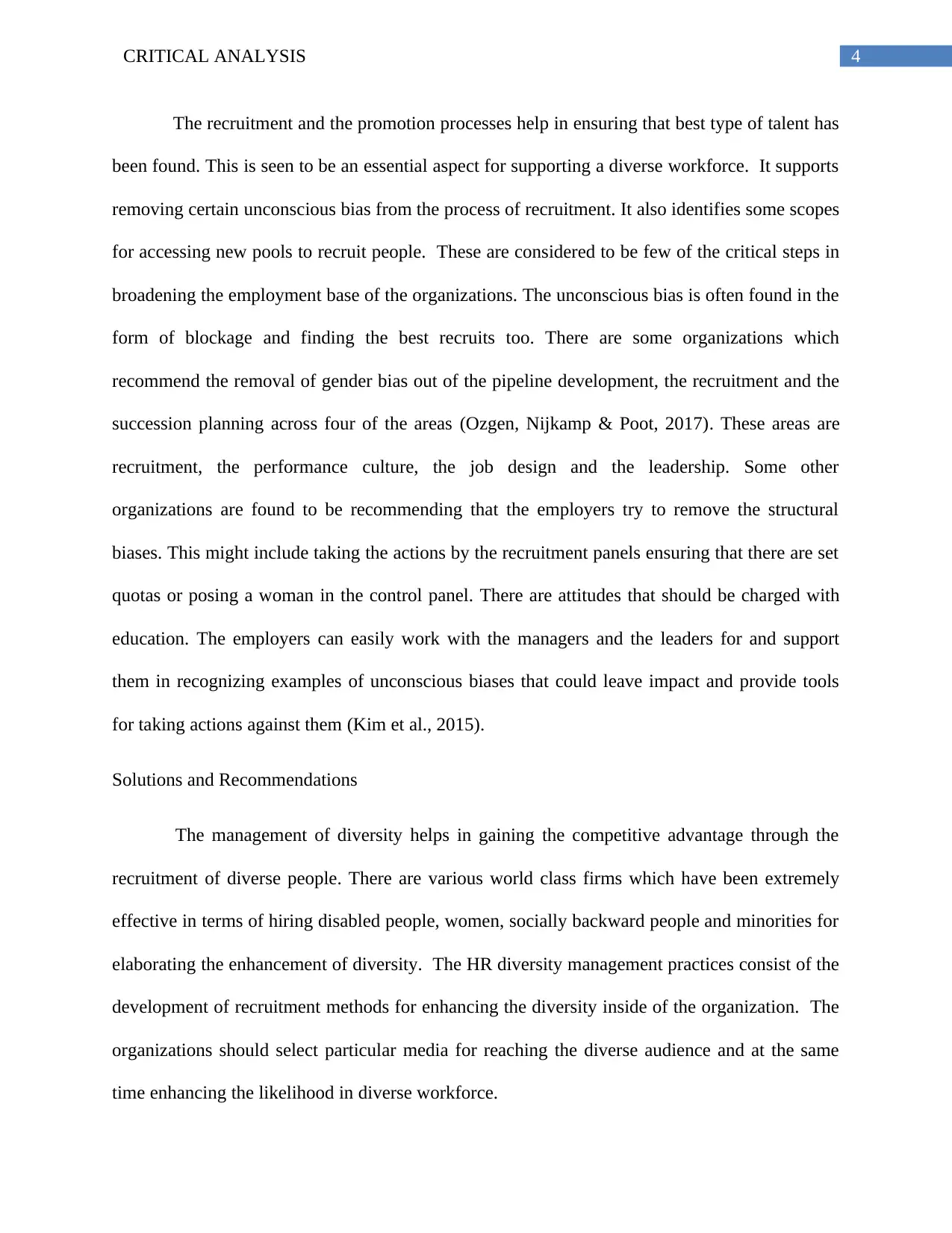
4CRITICAL ANALYSIS
The recruitment and the promotion processes help in ensuring that best type of talent has
been found. This is seen to be an essential aspect for supporting a diverse workforce. It supports
removing certain unconscious bias from the process of recruitment. It also identifies some scopes
for accessing new pools to recruit people. These are considered to be few of the critical steps in
broadening the employment base of the organizations. The unconscious bias is often found in the
form of blockage and finding the best recruits too. There are some organizations which
recommend the removal of gender bias out of the pipeline development, the recruitment and the
succession planning across four of the areas (Ozgen, Nijkamp & Poot, 2017). These areas are
recruitment, the performance culture, the job design and the leadership. Some other
organizations are found to be recommending that the employers try to remove the structural
biases. This might include taking the actions by the recruitment panels ensuring that there are set
quotas or posing a woman in the control panel. There are attitudes that should be charged with
education. The employers can easily work with the managers and the leaders for and support
them in recognizing examples of unconscious biases that could leave impact and provide tools
for taking actions against them (Kim et al., 2015).
Solutions and Recommendations
The management of diversity helps in gaining the competitive advantage through the
recruitment of diverse people. There are various world class firms which have been extremely
effective in terms of hiring disabled people, women, socially backward people and minorities for
elaborating the enhancement of diversity. The HR diversity management practices consist of the
development of recruitment methods for enhancing the diversity inside of the organization. The
organizations should select particular media for reaching the diverse audience and at the same
time enhancing the likelihood in diverse workforce.
The recruitment and the promotion processes help in ensuring that best type of talent has
been found. This is seen to be an essential aspect for supporting a diverse workforce. It supports
removing certain unconscious bias from the process of recruitment. It also identifies some scopes
for accessing new pools to recruit people. These are considered to be few of the critical steps in
broadening the employment base of the organizations. The unconscious bias is often found in the
form of blockage and finding the best recruits too. There are some organizations which
recommend the removal of gender bias out of the pipeline development, the recruitment and the
succession planning across four of the areas (Ozgen, Nijkamp & Poot, 2017). These areas are
recruitment, the performance culture, the job design and the leadership. Some other
organizations are found to be recommending that the employers try to remove the structural
biases. This might include taking the actions by the recruitment panels ensuring that there are set
quotas or posing a woman in the control panel. There are attitudes that should be charged with
education. The employers can easily work with the managers and the leaders for and support
them in recognizing examples of unconscious biases that could leave impact and provide tools
for taking actions against them (Kim et al., 2015).
Solutions and Recommendations
The management of diversity helps in gaining the competitive advantage through the
recruitment of diverse people. There are various world class firms which have been extremely
effective in terms of hiring disabled people, women, socially backward people and minorities for
elaborating the enhancement of diversity. The HR diversity management practices consist of the
development of recruitment methods for enhancing the diversity inside of the organization. The
organizations should select particular media for reaching the diverse audience and at the same
time enhancing the likelihood in diverse workforce.
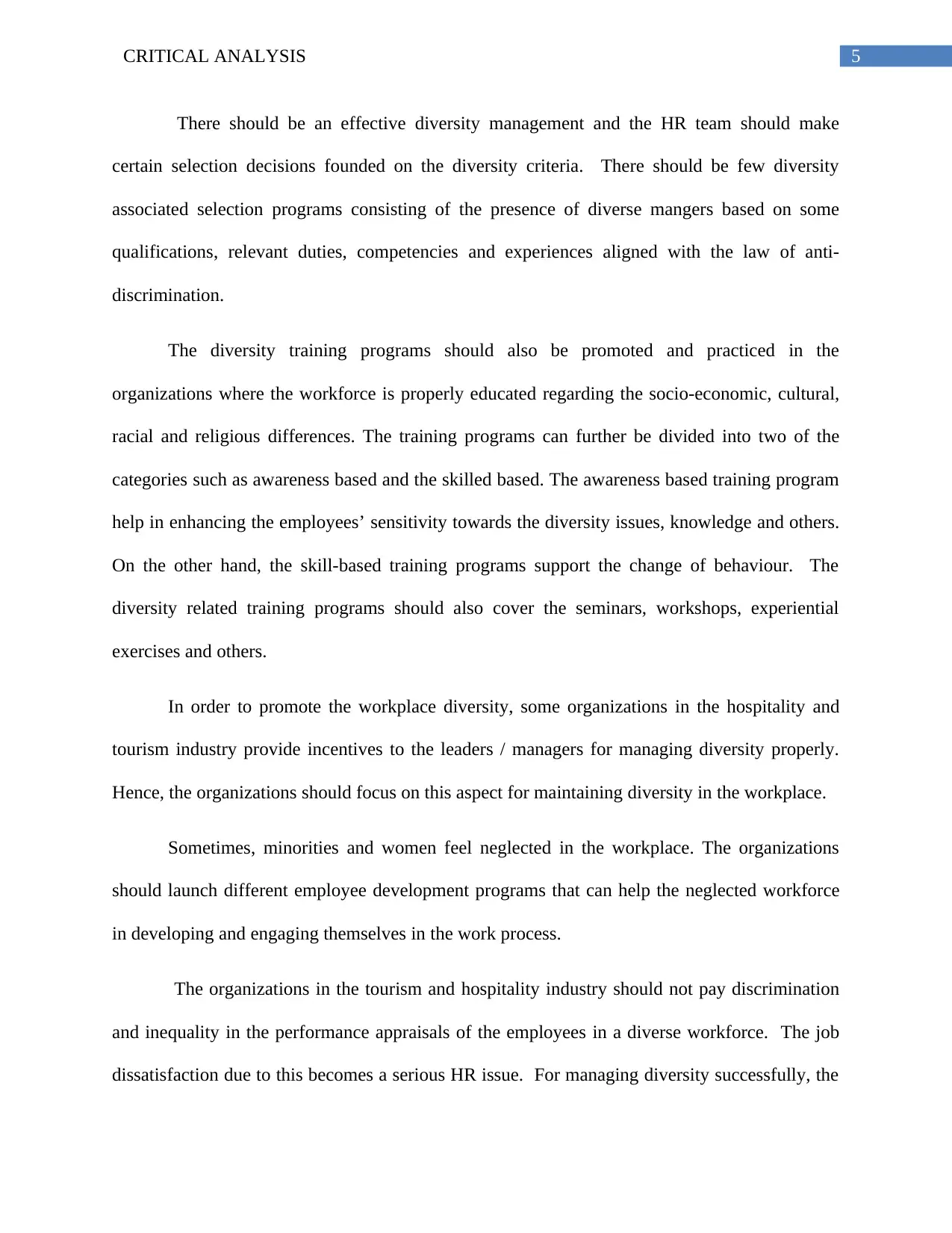
5CRITICAL ANALYSIS
There should be an effective diversity management and the HR team should make
certain selection decisions founded on the diversity criteria. There should be few diversity
associated selection programs consisting of the presence of diverse mangers based on some
qualifications, relevant duties, competencies and experiences aligned with the law of anti-
discrimination.
The diversity training programs should also be promoted and practiced in the
organizations where the workforce is properly educated regarding the socio-economic, cultural,
racial and religious differences. The training programs can further be divided into two of the
categories such as awareness based and the skilled based. The awareness based training program
help in enhancing the employees’ sensitivity towards the diversity issues, knowledge and others.
On the other hand, the skill-based training programs support the change of behaviour. The
diversity related training programs should also cover the seminars, workshops, experiential
exercises and others.
In order to promote the workplace diversity, some organizations in the hospitality and
tourism industry provide incentives to the leaders / managers for managing diversity properly.
Hence, the organizations should focus on this aspect for maintaining diversity in the workplace.
Sometimes, minorities and women feel neglected in the workplace. The organizations
should launch different employee development programs that can help the neglected workforce
in developing and engaging themselves in the work process.
The organizations in the tourism and hospitality industry should not pay discrimination
and inequality in the performance appraisals of the employees in a diverse workforce. The job
dissatisfaction due to this becomes a serious HR issue. For managing diversity successfully, the
There should be an effective diversity management and the HR team should make
certain selection decisions founded on the diversity criteria. There should be few diversity
associated selection programs consisting of the presence of diverse mangers based on some
qualifications, relevant duties, competencies and experiences aligned with the law of anti-
discrimination.
The diversity training programs should also be promoted and practiced in the
organizations where the workforce is properly educated regarding the socio-economic, cultural,
racial and religious differences. The training programs can further be divided into two of the
categories such as awareness based and the skilled based. The awareness based training program
help in enhancing the employees’ sensitivity towards the diversity issues, knowledge and others.
On the other hand, the skill-based training programs support the change of behaviour. The
diversity related training programs should also cover the seminars, workshops, experiential
exercises and others.
In order to promote the workplace diversity, some organizations in the hospitality and
tourism industry provide incentives to the leaders / managers for managing diversity properly.
Hence, the organizations should focus on this aspect for maintaining diversity in the workplace.
Sometimes, minorities and women feel neglected in the workplace. The organizations
should launch different employee development programs that can help the neglected workforce
in developing and engaging themselves in the work process.
The organizations in the tourism and hospitality industry should not pay discrimination
and inequality in the performance appraisals of the employees in a diverse workforce. The job
dissatisfaction due to this becomes a serious HR issue. For managing diversity successfully, the
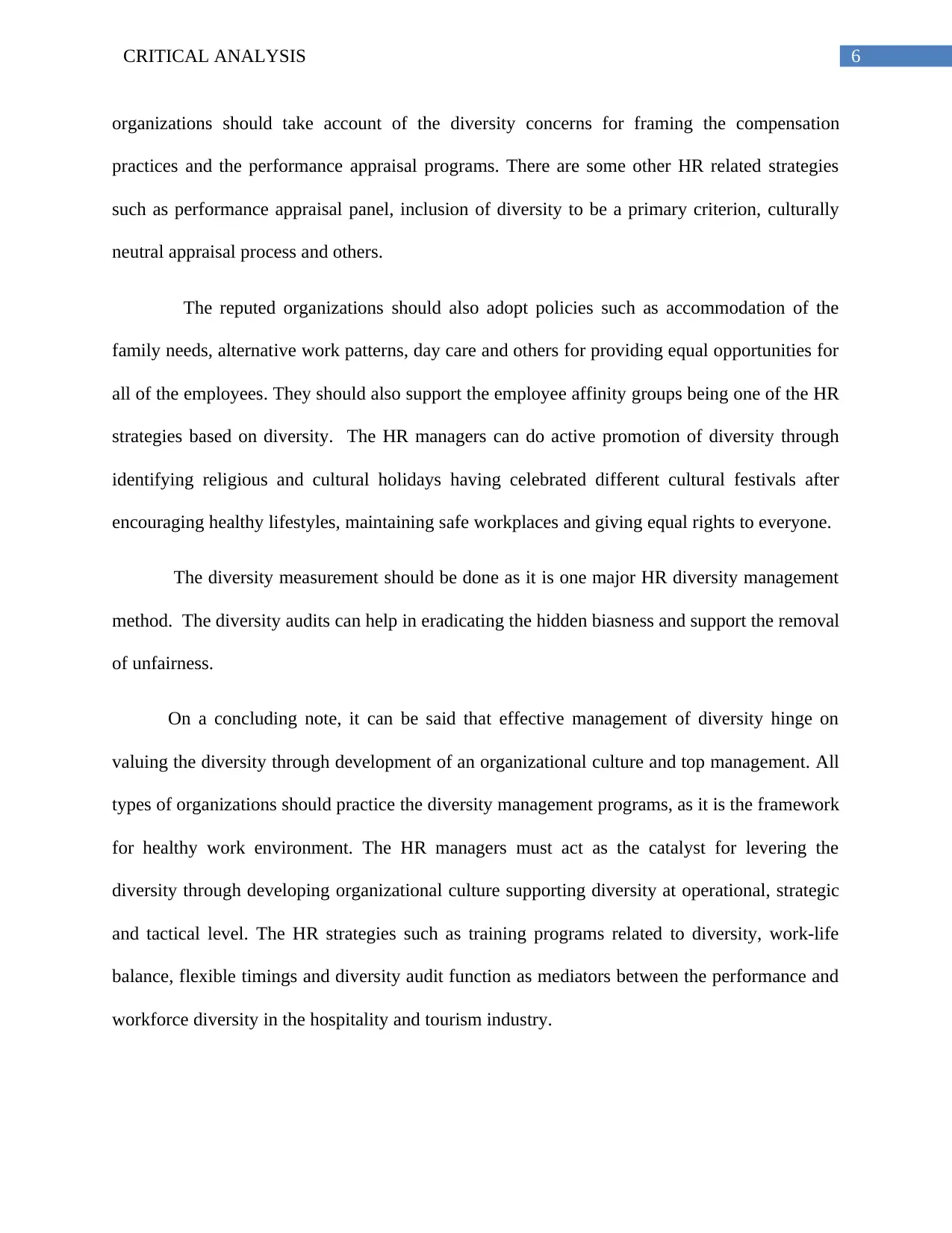
6CRITICAL ANALYSIS
organizations should take account of the diversity concerns for framing the compensation
practices and the performance appraisal programs. There are some other HR related strategies
such as performance appraisal panel, inclusion of diversity to be a primary criterion, culturally
neutral appraisal process and others.
The reputed organizations should also adopt policies such as accommodation of the
family needs, alternative work patterns, day care and others for providing equal opportunities for
all of the employees. They should also support the employee affinity groups being one of the HR
strategies based on diversity. The HR managers can do active promotion of diversity through
identifying religious and cultural holidays having celebrated different cultural festivals after
encouraging healthy lifestyles, maintaining safe workplaces and giving equal rights to everyone.
The diversity measurement should be done as it is one major HR diversity management
method. The diversity audits can help in eradicating the hidden biasness and support the removal
of unfairness.
On a concluding note, it can be said that effective management of diversity hinge on
valuing the diversity through development of an organizational culture and top management. All
types of organizations should practice the diversity management programs, as it is the framework
for healthy work environment. The HR managers must act as the catalyst for levering the
diversity through developing organizational culture supporting diversity at operational, strategic
and tactical level. The HR strategies such as training programs related to diversity, work-life
balance, flexible timings and diversity audit function as mediators between the performance and
workforce diversity in the hospitality and tourism industry.
organizations should take account of the diversity concerns for framing the compensation
practices and the performance appraisal programs. There are some other HR related strategies
such as performance appraisal panel, inclusion of diversity to be a primary criterion, culturally
neutral appraisal process and others.
The reputed organizations should also adopt policies such as accommodation of the
family needs, alternative work patterns, day care and others for providing equal opportunities for
all of the employees. They should also support the employee affinity groups being one of the HR
strategies based on diversity. The HR managers can do active promotion of diversity through
identifying religious and cultural holidays having celebrated different cultural festivals after
encouraging healthy lifestyles, maintaining safe workplaces and giving equal rights to everyone.
The diversity measurement should be done as it is one major HR diversity management
method. The diversity audits can help in eradicating the hidden biasness and support the removal
of unfairness.
On a concluding note, it can be said that effective management of diversity hinge on
valuing the diversity through development of an organizational culture and top management. All
types of organizations should practice the diversity management programs, as it is the framework
for healthy work environment. The HR managers must act as the catalyst for levering the
diversity through developing organizational culture supporting diversity at operational, strategic
and tactical level. The HR strategies such as training programs related to diversity, work-life
balance, flexible timings and diversity audit function as mediators between the performance and
workforce diversity in the hospitality and tourism industry.
Paraphrase This Document
Need a fresh take? Get an instant paraphrase of this document with our AI Paraphraser
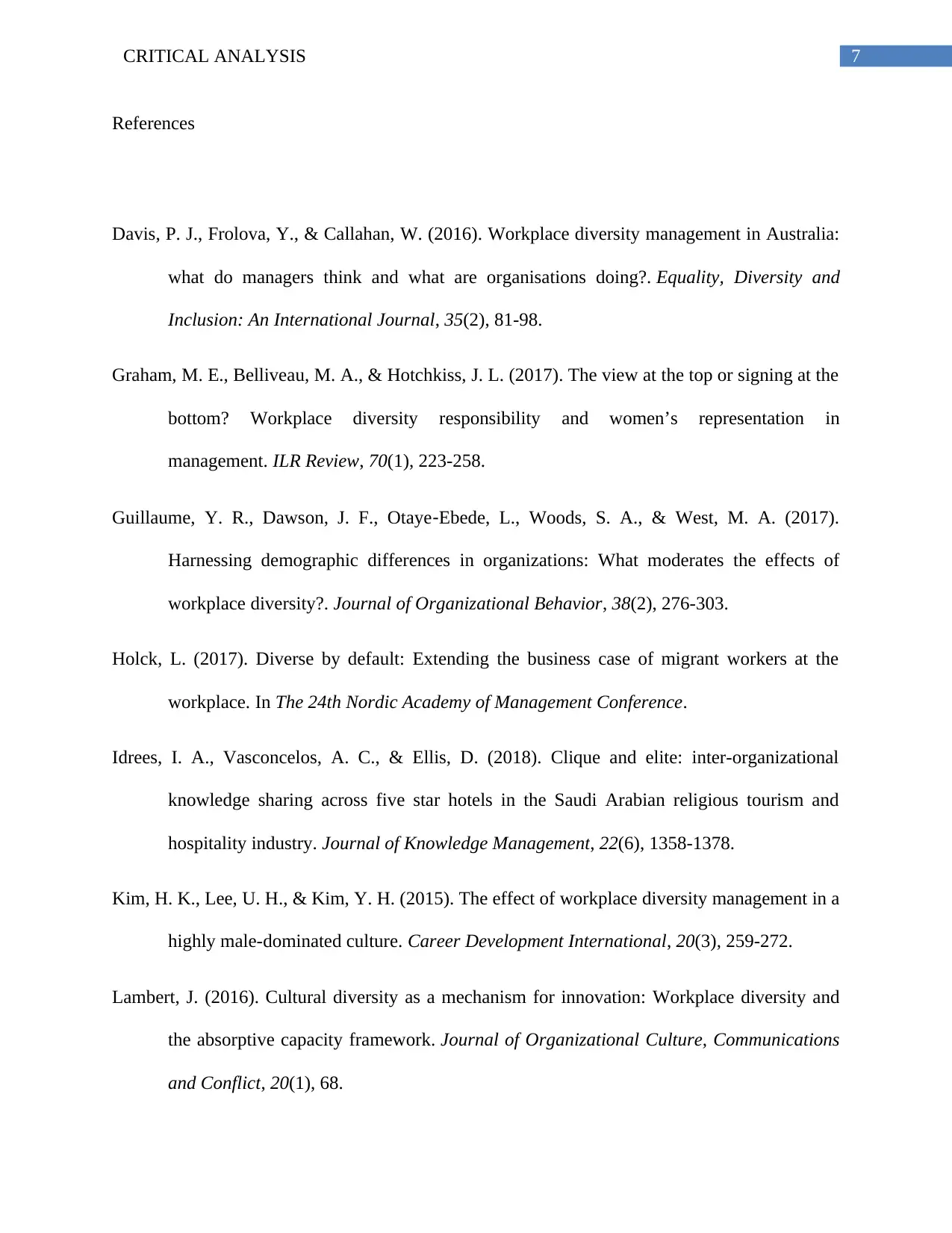
7CRITICAL ANALYSIS
References
Davis, P. J., Frolova, Y., & Callahan, W. (2016). Workplace diversity management in Australia:
what do managers think and what are organisations doing?. Equality, Diversity and
Inclusion: An International Journal, 35(2), 81-98.
Graham, M. E., Belliveau, M. A., & Hotchkiss, J. L. (2017). The view at the top or signing at the
bottom? Workplace diversity responsibility and women’s representation in
management. ILR Review, 70(1), 223-258.
Guillaume, Y. R., Dawson, J. F., Otaye‐Ebede, L., Woods, S. A., & West, M. A. (2017).
Harnessing demographic differences in organizations: What moderates the effects of
workplace diversity?. Journal of Organizational Behavior, 38(2), 276-303.
Holck, L. (2017). Diverse by default: Extending the business case of migrant workers at the
workplace. In The 24th Nordic Academy of Management Conference.
Idrees, I. A., Vasconcelos, A. C., & Ellis, D. (2018). Clique and elite: inter-organizational
knowledge sharing across five star hotels in the Saudi Arabian religious tourism and
hospitality industry. Journal of Knowledge Management, 22(6), 1358-1378.
Kim, H. K., Lee, U. H., & Kim, Y. H. (2015). The effect of workplace diversity management in a
highly male-dominated culture. Career Development International, 20(3), 259-272.
Lambert, J. (2016). Cultural diversity as a mechanism for innovation: Workplace diversity and
the absorptive capacity framework. Journal of Organizational Culture, Communications
and Conflict, 20(1), 68.
References
Davis, P. J., Frolova, Y., & Callahan, W. (2016). Workplace diversity management in Australia:
what do managers think and what are organisations doing?. Equality, Diversity and
Inclusion: An International Journal, 35(2), 81-98.
Graham, M. E., Belliveau, M. A., & Hotchkiss, J. L. (2017). The view at the top or signing at the
bottom? Workplace diversity responsibility and women’s representation in
management. ILR Review, 70(1), 223-258.
Guillaume, Y. R., Dawson, J. F., Otaye‐Ebede, L., Woods, S. A., & West, M. A. (2017).
Harnessing demographic differences in organizations: What moderates the effects of
workplace diversity?. Journal of Organizational Behavior, 38(2), 276-303.
Holck, L. (2017). Diverse by default: Extending the business case of migrant workers at the
workplace. In The 24th Nordic Academy of Management Conference.
Idrees, I. A., Vasconcelos, A. C., & Ellis, D. (2018). Clique and elite: inter-organizational
knowledge sharing across five star hotels in the Saudi Arabian religious tourism and
hospitality industry. Journal of Knowledge Management, 22(6), 1358-1378.
Kim, H. K., Lee, U. H., & Kim, Y. H. (2015). The effect of workplace diversity management in a
highly male-dominated culture. Career Development International, 20(3), 259-272.
Lambert, J. (2016). Cultural diversity as a mechanism for innovation: Workplace diversity and
the absorptive capacity framework. Journal of Organizational Culture, Communications
and Conflict, 20(1), 68.
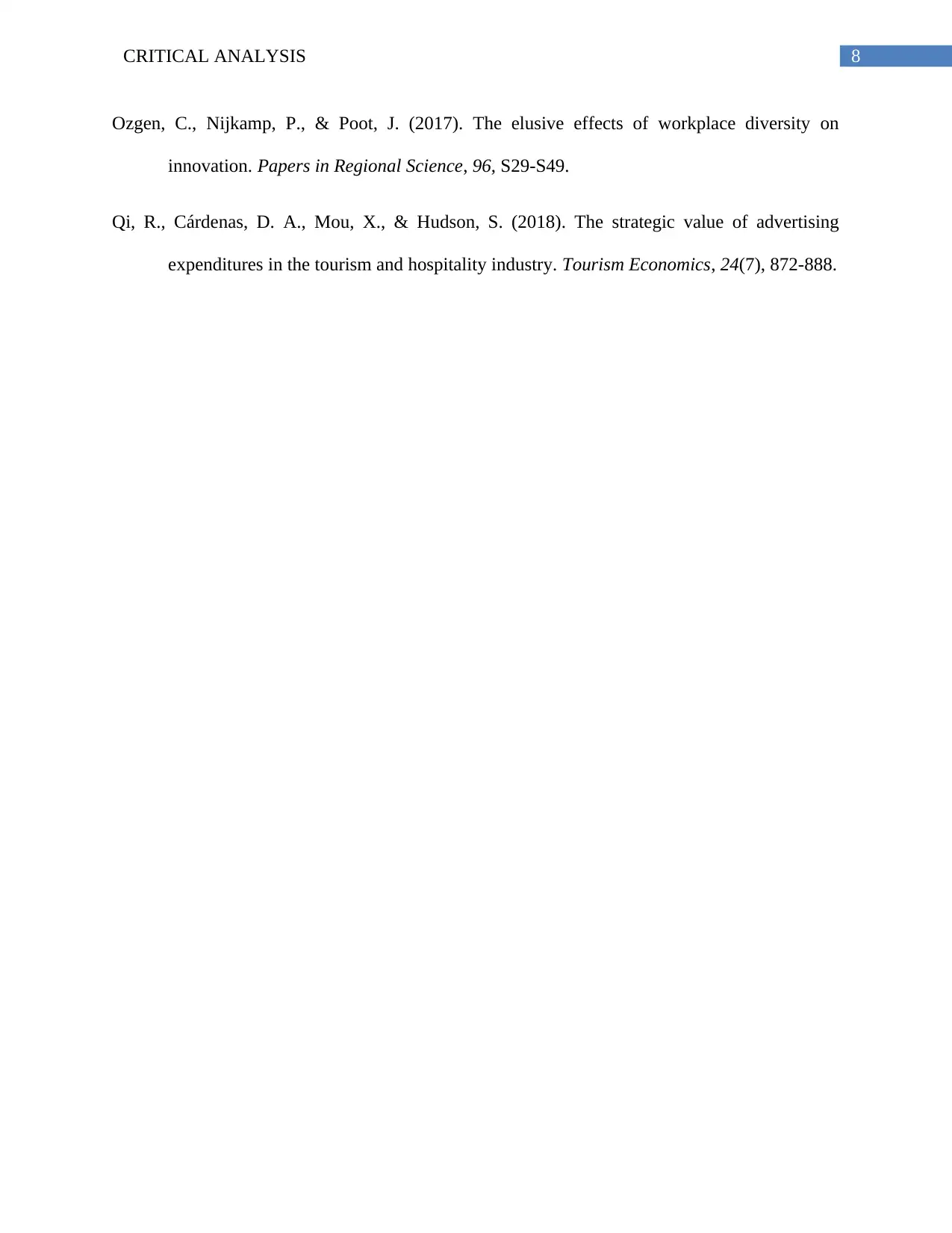
8CRITICAL ANALYSIS
Ozgen, C., Nijkamp, P., & Poot, J. (2017). The elusive effects of workplace diversity on
innovation. Papers in Regional Science, 96, S29-S49.
Qi, R., Cárdenas, D. A., Mou, X., & Hudson, S. (2018). The strategic value of advertising
expenditures in the tourism and hospitality industry. Tourism Economics, 24(7), 872-888.
Ozgen, C., Nijkamp, P., & Poot, J. (2017). The elusive effects of workplace diversity on
innovation. Papers in Regional Science, 96, S29-S49.
Qi, R., Cárdenas, D. A., Mou, X., & Hudson, S. (2018). The strategic value of advertising
expenditures in the tourism and hospitality industry. Tourism Economics, 24(7), 872-888.
1 out of 9
Related Documents
Your All-in-One AI-Powered Toolkit for Academic Success.
+13062052269
info@desklib.com
Available 24*7 on WhatsApp / Email
![[object Object]](/_next/static/media/star-bottom.7253800d.svg)
Unlock your academic potential
© 2024 | Zucol Services PVT LTD | All rights reserved.




